|
|
|
|
|
|

Name: Cinci Mănăstiri (Five Monasteries).
There are more monasteries in the area, but these five are considered to be particularly beautiful.
Four of the five are listed as UNESCO World Heritage buildings. As there are:
Es gibt noch mehr in der Region, aber fünf Klöster gelten als besonders schön und
wurden gar zum UNESCO-Weltkulturerbe erklärt. Dies sind
→Mănăstirea Humorului (Humor Monastery),
→Mănăstirea Voroneţ (Voronets Monastery),
→Mănăstirea Moldoviţa (Moldovitsa Monastery),
→Mănăstirea Suceviţa (Sucevitsa Monastery) and
→Mănăstirea Arbore (Arbore Monastery).
Location:
The monasteries are located in the central part of the Southern Bukovina
(which means 'Land of the Beeches'), around 350 km north of →Bucharest
and 30 to 60 km west of →Suceava. The area around Arbore monastery is
rather flat, but the other monasteries are hidden in the mountains, which belong to the Carpathian Mountains.
Getting there: To cut a long story short: It's definitely impossible to see the
five monasteries within one or two days when you rely on public transport and/or hitchhiking.
The distance between some of the monasteries is too long, and some streets are only frequented by one or two
horse carts per hour. The best base for exploring the monasteries is the small town of
Gura Humorului. There are several hotels and pensions in town.
Additionally, it's well served with local and long-distance train connections.
The closest bigger city is →Suceava, which is also a great base for
touring around. From there, many daily trains run westwards via →Vatra Dornei to
→Cluj-Napoca. All of these trains stop in Gura Humorului.
If you don't have the time to stay in the area for several days, it's best to hire a car and a driver. The tour takes around
6 to 7 hours; the usual fare is 2,500,000 Lei (appr. € 60) no matter how many people you are.
Hiring your own car has a great advantage - you can stop wherever you are and stay as long as you want.
History: At the beginning of the 16th century, Moldavia incl. the Bukovina
was more and more threatened by the advancing Ottomans. And so the people decided to fortify
the monasteries in the area. These monasteries are also known as defend churches.
Monasteries were also used as assembly points. In order to teach soldiers and farmers the history of the
country as well as the bible, the inner and outer walls of the churches were covered with frescoes in a
very unique way. The frescoes are more or less well-preserved, and so they were declared
World Cultural Heritage by the UNESCO in the 1990ies - except Suceviţa monastery.
Admission fee: Most monasteries open from 10 am to 6 pm.
In winter (and the winter is quite long in this part of the country), some roads may become
impassable - especially the minor road between Moldoviţa and Suceviţa.
Except for Arbore monastery, the admission fee for each monastery is 40,000 Lei (€ 1); a photo permit
costs 60,000 Lei and a video permit 100,000 Lei. We are talking about Orthodox monasteries, so
women should cover their shoulders and men should wear appropriate (eg no shorts) clothes, too.
|
|
|
|
|
|
|
Location and how to get there: Humor monastery is around 7 km north of
Gura Humorului (see map above). Buses run from the town to the entrance of the monastery.
Humor is located at the foot of the mountains, beautifully surrounded by forests and meadows.
About the monastery: This monastery was founded in the year 1530, the frescoes were
added five years later. The monastery itself is comparatively small and only surrounded by a wooden fence, which is quite
unusual. Another characteristic feature is the fact, that it's the only monastery among the five without a tower on the
top of the church.
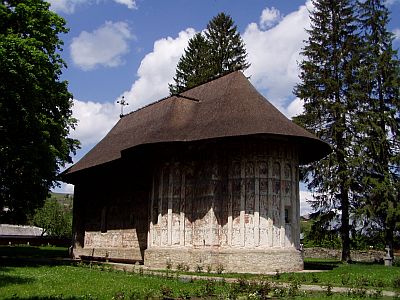
| |
The main church of Humor Monastery
|
Unfortunately, many of the frescoes had faded and are not recognizable any longer. Only wide parts of the frescoes covering the
southern front are well preserved. The frescoes depict the same thing other frescoes in the area do as well: the fight against
the Ottoman intruders. They also show the Holy Virgin - not less than the patron saint of Humor monastery. The outer frescoes
are dominated by a reddish hue. Inside, the church is divided into five rather small chambers, containing many other, very detailed
frescoes. It would take hours to admire all the frescoes inside the church.
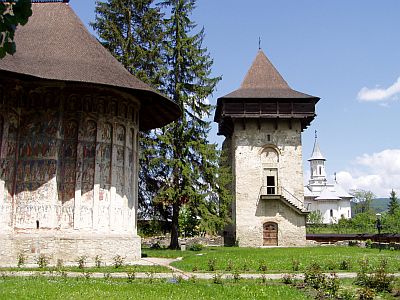
| |
Monastery church, watchtower and a new church
|
As a matter of fact, all monastery churches consist of several chambers. As there are the anteroom, usually guarded by a nun
selling devotional items, the prayer room, the burial chamber and finally the altar room. In Humor monastery, there's an additional
treasury hidden above the anteroom.
Location and how to get there: Voroneţ Monastery is around 8 km away from
Gura Humorului to the south at the end of a dusty road. The monastery lies next to a small village
with the same name right at the foot of the mountains.
About the monastery: No less a person than the national hero Ştefan cel Mare (Stephen the Great)
ordered the construction of the monastery and dedicated it to an abbot who encouraged Stephen to keep on fighting against the Turks.
The construction was completed in 1488.
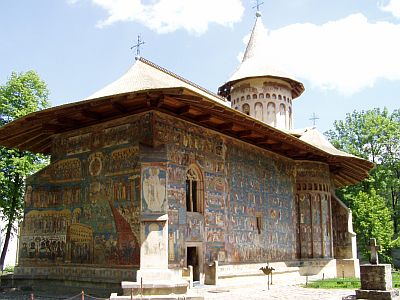
| |
General view: The impact of the paintings is just overwhelming
|
Voronets Monastery is surrounded by thick walls and therefore heavily fortified.
As for the frescoes of the northern wall, only half of it is preserved. More impressive are the frescoes covering the
western and southern wall of the church. The compactness and the luminosity of the paintings leave the visitor
dumbfounded for a moment. Here, a bright blue dominates the frescoes.
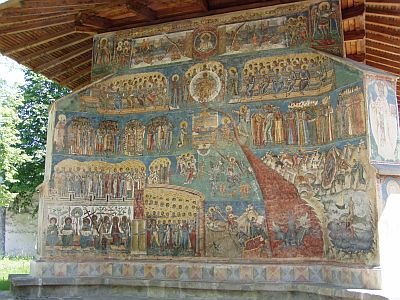
| |
Western wall: the Last Judgement
|
The narrow western wall is particularly impressive. In all monasteries, the western wall marks the back of the church, since
the monasteries are orientated towards the East (Fiat Lux!). The western wall depicts the Last Judgement.
Angels announce the end of the world, and the doomed are sorted into believers and unbelievers. What is tabibito,
an atheist fundamentalist (wink) supposed to say about that!?
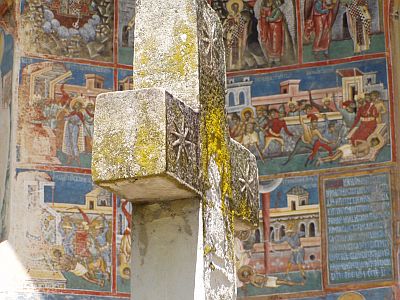
| |
Moss-covered cross before the southern wall
|
The monastery is well frequented by German, Japanese and other pensioner groups loitering in and around the monastery.
The number will definitely increase within the next years. Nevertheless it's a very special atmosphere inside the monasteries,
which are nowadays mostly inhabited and maintained by nuns. A closer look at the frescoes can be somewhat shocking.
The motifs are as cruel and bloody as the bible is. Beheading, mutilating, strangulating - you won't miss anything.
These are motifs I've never seen in any Buddhist temple or Shintoist shrine. But I can't and won't make a statement on this.
Location and how to get there: This monastery is located more than 20 km north of
Cămpulung Moldovenesc, which is en route the important railroad between the west and the
east of Northern Romania. There's also a minor railroad to the village with the same name (Mănăstirea Moldoviţa),
but I'm not sure whether this route is still served. If yes - the train starts from Vama, which is halfway
between Cămpulung Moldovenesc and Gura Humorului. The monastery lies in the middle of the scenic village.
About the monastery: Obviously, this monastery has recently been given a massive facelift - everything looks
new. The heavy fortification including very thick walls is one of the distinctive features of the monastery. However,
many of the frescoes covering the outer walls are heavily damaged not to say forever lost. The monastery was built in 1532, most of the frescoes followed
in 1537.
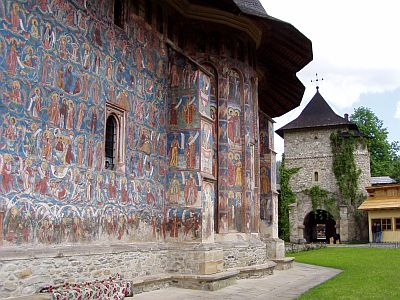
| |
The Moldavian Monastery and the main entrance
|
The frescoes depicting the battle of Constantinople are worth a closer look. There, Persians dressed as Turks are trying to
attack a Christian fortress. Another unusual feature is the open anteroom, but most of the frescoes there are
widely damaged.
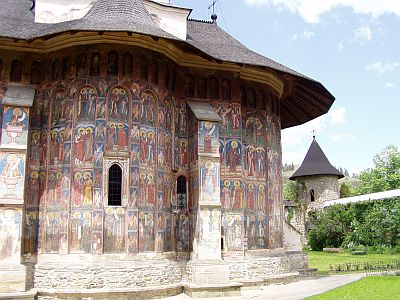
| |
In this monastery, the colours blue and red dominate
|
Not just the monastery but the entire village nearby are worth an extensive walk. The village consists of old
wooden farmhouses with a well incl. a large hand wheel and a tiny hut built around the well in front of it. It's definitely a good idea
to not just stick to the monastery but to explore the village as well. Not far from the monastery, there's the 1,109 metres
high Ciumârna pass. The pass road there is very scenic.
Location and how to get there: This monastery occupies a small valley in the middle of
the mountains not far from Ciumarna Pass. The valley is not accessible by train. The next bigger town Rădăuti
is 20 km away to the west. There's a small town with the same name as the monastery. Sucevitsa Monastery lies at the edge of the town.
About the monastery:
Sucevitsa Monastery is the biggest among the five monasteries and almost fortified like a castle. The church
inside was completed in 1586, which means that it's the youngest one. Although the church incl. the frescoes and
everything around were extensively restored, this monastery is not listed as a UNESCO World Heritage building.
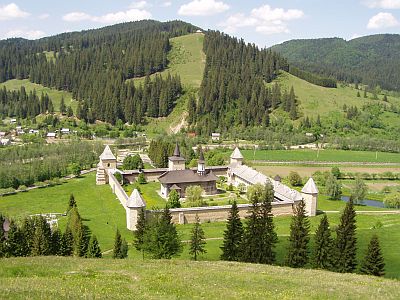
| |
The fully restored monastery and the lovely settings
|
Behind the monastery, there's a grass-covered, steep hill with a fence around it. The fence is only for the sheeps,
so you can cross it on a small ladder attached to the fence. The view over the valley and the monastery from the top
is breathtaking. The monastery, which was inhabitated by some nuns even during socialist times, houses a small museum.
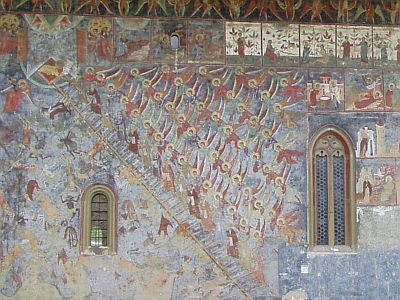
| |
The staircase from heaven to hell counts 32 steps
|
As soon as you enter the monastery, you will be attracted by a large, characteristic frescoe. It's called 'Staircase to Heaven' and
depicts a long staircase from hell on the right bottom to heaven on the left top. Most of the folks on the lower steps are
dressed as Turks - clearly a mirror of the time this fresco was created. People were frightened by the idea that the Ottomans
would invade the Bukovina as well.
Arbore Monastery (Arbore = tree)
Location and how to get there:
Arbore lies in the middle of the rather large village Arbore and is some kilometres away from the mountains.
This monastery is far less spectacular and smaller than the others. To →Suceava it's around 30 km. There's only
one bus a day, leaving from Gura Humorului in the late afternoon. Public transport here is quite useless so to say.
About the monastery:
Since there are only a few frescoes left - all of them on the Eastern wall - Arbore is less impressive compared to the
other four monasteries. However, the interior is definitely worth a closer look.
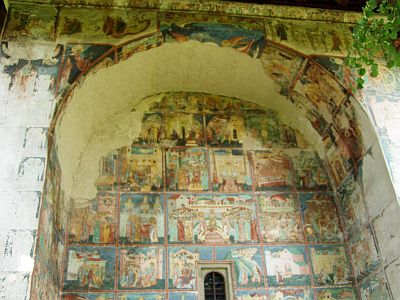
| |
The only preserved frescoes of Arbore monastery
|
The frescoes are dominated by a somewhat greenish-blue colour. The monastery was built in the year 1503 and
contains an interesting Gothic tomb inside the church. An older couple is looking after the visitors. The lady can
"only" speak French, but she's incredibly friendly and showed us around explaining everything patiently (oui, en français).
Opposite the monastery there's a very colourful and somehow fascinating cemetary. By now, Arbore monastery is not
inhabitated.
|
|
|
|
|
|
|
If you have plenty of time and maybe even your own bicycle, car or bike, it's best
to stay in or around Gura Humorului. There are many camp sites, hotels and
a lot of private accommodation around the area. It's even possible to stay in some
of the monasteries, but space is limited.
Another option is to stay in Suceava and hire a car + driver there. See also
→Accommodation in Suceava.
|
|
|
|
|
|
|
www.geocities.com/ghedani1
Extensive website about the monasteries in the Bukovina, incl. nice pictures. English
www.infotravelromania.ro/en/monastery.html
Another page about the monasteries by InfoTravelRomania.
Do you have or do you know a good website about the monasteries or the Bucovina? Don't hesitate, let me know!
After checking it, I would love to add it to the link list.
Please note that commercial websites will be declined. For e-mail link see menu on the left.
|
|
| |










